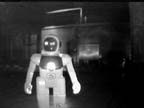:: Monday, November 15, 2004 ::

NEW.WRITING: “IL SITUAZIONAUTA”
BY: Francesca De Nicolò
Pino Boresta is an artist who lives in Segni, near Rome, Italy. And who, for many years, has engaged in being an artist “against”, (as we have seen), a lot of things. Boresta's work was seen recently at the Parco of Aguzzano in Rome from 11 - 28 September. He presented his audio-installation UCCELLI FANTASTICI, where he performed as a conceptual hacker hacking in real time, and, also, as a great bluffer.
We can see from this example, that Boresta has researched "Shit Art." Looking at Claudio Morici 's book Teorie a tecnica di un’artista di Merda (June 2004), heavily connected to and influenced by the great Philip Dick, a "Shit Artist", according to Morici, is an artist who doesn’t ’t live off of his art. He doesn't accept the classical problems connected with a common way of life: Money is not an issue for him. So this artist of "shit” works in other ways, and he strives to be alive in this mood of convenience because he doesn’t live by his art. But he is still an artist, knowing his destiny, without the need to be famous. But what does this mean?
Boresta is also a joker: An artist who wants to pirate common sense thinking. He permeates the detournament of the net with web projects. And in accord with Guy Debord’s theory and critique of the society of spectacle, Boresta is still fascinated, as he has said to me, by the web, by net art, and by the Internet as a new democratic system of communication.
Boresta has two projects online, cryptically and cynically called, Where do spermatozoa go? and Hey Friend What’s Matter. The aim of the first project is to make public an intimate occurrence, creating a "romantic" union between life and art. In this situation, Boresta, embraces a Punk view, making himself part of the joke of the spectacle, without limits.
He creates a sort of short circuit in the line of thinking where everything can be art. And where every one can search and see everyone else having a relationship with Boresta's life, connected in virtual reality by his single machine.
So, according to this view and for the purpose of this experiment, Boresta has included photos of his son, his father, and his wife. In this clinical view of his "life" Boresta has, like a paranoid, calculated all the orgasmic hours of life. It is a situation that has a lot of the dark humor. It is a work in progress that never ends, like an Internet list where all the participants are emailing each other little tales, thoughts, poetry, and music. And all they want from these discussions about the nonsense of being human is deciding who is in the most time grotesque and shining.
In Hey Friend what’s the matter, Boresta speaks about a situation, real or imagined, where he witnessed the suicide of a man when he was in London. He asks visitors to extend a judgment and impart a point of view on the issue of how one might possibility better the life of someone else.
Related to this theme, Boresta presents a continuous experiment about the democratization of the net -- a Neoist exploration on the culpability of a new era that has been reformatted by the impact of new media, and that has changed pervasively the ordinary sense and material vision of the world, as we know it.
http://www.arteutile.net/boresta/boresta2.htm
http://www.arteutile.net/boresta/boresta.htm

ORIGINAL POST: Wednesday, November 10, 2004
BY: Garrett Lynch
We don't see enough performance/live-based work on or using the network, and less still that is sited in the "real" world yet reliant on the "virtual" in some way. This is a real surprise, seeing as one of the strong points of the network is its possibility to give a sense of immediacy. The network alone can't be used to see actions occurring, but it can be used to instigate those actions; and this can be from the "virtual" to the "real," and vice-versa.
It's true that most net art is interactive and, therefore, live for the user, but only as a closed system; inputs and their parameters are predefined, meaning their output is within an anticipated framework. There is seldom influence outside of that framework, nor is it seen by simultaneous users. Open systems--precisely what art used to be, heavily reliant on audience interaction, reaction etc.--is rare these days.
Ballettikka Internettikka is a work to be performed by Igor Stromajer & Brane Zorman and it will take place on Saturday, November 13th of 2004, at 20:00 (GMT+1). It is very much a performance-based work that uses and broadcasts on networks.
Essentially, "Stromajer and Zorman are going to operate remote-controlled toy-ballet-robots. MC Brane is going to conduct a wireless MP3 orchestra!" during an invasion of a famous theatre/ballet/opera house somewhere in Europe. This is not the first time the two artists have done such an invasion. After having created a similar impromptu performance at the Bolshoi Theatre in Moscow, on March of 2002, the artists are now developing the work further through extended use of networks. Hi-tech mobile and wireless equipment will be employed for the invasion, and the live broadcast from their website over the Internet will start at 20:00 (GMT+1) sharp. Be sure not to miss what will undoubtedly be an unusual performance!

ORIGINAL POST: Friday, November 05, 2004
BY: Daniele Balit
Dopo quello a cui ci ha abituato la Unileveler Series della Tate Modern di Londra, (ragni giganteschi, soli postatomici) si rimane spiazzati nel trovare la Turbine Hall assolutamente vuota. E la nuova commissione a Bruce Nauman? E le sue scritte in neon, le installazioni, i video taglienti? La risposta arriva presto quando si attraversa la sala e si cominciano a sentire frasi come: “I was a bad boy, you were a bad boy, we were bad boys...” (un inconfondibile estratto da un lavoro del 1985). Presto ci si rende conto come la Turbine Hall sia riempita solo di elementi sonori sonori, di voci che attraversano lo spazio creando una moltitudine di traiettorie di percezione uditiva. Raw Materials è infatti una gigantesca scultura sonora di Bruce Nauman che reinterpreta il lavoro di una vita (e che lavoro!) proponendo nuovi codici di lettura di 22 diverse sue opere. Mi è piaciuta molto anche la proposizione del lavoro su Internet, in grado di offrire un’ottima esperienza virtuale di attraversamento dello spazio acustico creatosi nella sala. Clicca qui per visitarla.